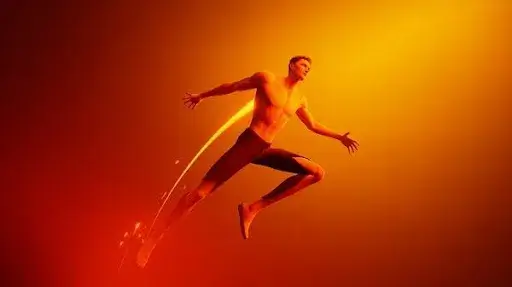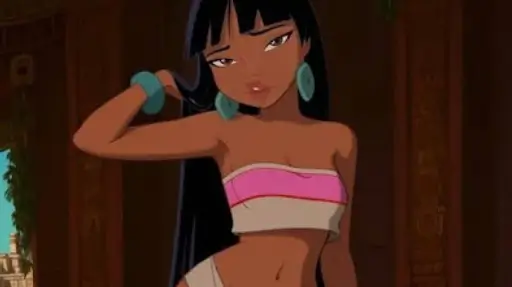Good animation isn’t only about movement. It’s about how that movement feels. Smooth, believable motion has a rhythm to it — and that rhythm almost always follows arcs. Skip them, and the result looks stiff, robotic, and disconnected from reality. Add them, and suddenly every action has weight, flow, and character.
One of the 12 rules of animation explains this perfectly. Arcs aren’t a fancy extra. They’re the principle that makes motion look alive.
What is an Arc?
An arc is simply a curve. When a character raises a hand, it doesn’t travel in a straight line up and down. The arm swings in a curve. Toss a ball, and its path bends through the air. Even something as small as a blink often follows a tiny curved path.
So, what are arcs in animation? It’s the practice of building these curved motions into your work instead of settling for stiff linear ones. Muscles, joints, and gravity all pull things away from rigid lines. Arcs capture that natural pull and give motion a flow audiences instantly recognize as real.
Why is Arc Important in Animation?
Look at a walk cycle. Without arcs, the knees snap like hinges on a machine. Add arcs, and the legs swing smoothly, shifting weight from one side to the other. Suddenly, it looks like a person instead of a robot.
Arcs do more than fix stiff movement:
- Weight and substance: Curves give actions a grounded, heavy feel.
- Character and mood: A soft arc feels calm, sharp arcs feel tense.
- Better pacing: Curves naturally speed up and slow down, like real physics.
- Emotional storytelling: A single curved gesture can say more than dialogue.
So if anyone asks, “Why is arc important?”, the honest answer is: without it, animation has no life.
Types of Arcs in Animation
Arcs don’t all look the same. Animators use different versions depending on what’s happening in the scene.
Linear Arc vs Circular Arc
- Linear arc: Technically not an arc at all. It’s a straight shot from one point to another. It works for lasers or machines, but it feels unnatural in living motion.
- Circular arc: A clean curve around a circle. Think of a spinning fan, a pendulum swinging, or a character twirling a rope. Circular arcs are smooth, predictable, and symmetrical.
That’s the big linear arc vs circular arc contrast. Straight lines feel mechanical. Circular arcs feel alive.
Elliptical Arcs
These are stretched circles — ovals. They create motion that speeds up in one part of the path and slows in another. Great for jumps, tosses, or any action that needs lift and drop. A basketball flying toward the hoop is a classic elliptical arc in action.
Irregular Arcs
Not every curve follows geometry. Some arcs are loose and messy, bending unpredictably. Hair swaying, clothes rippling, leaves caught in the wind — these motions are built from irregular arcs. They’re the secret to keeping animation organic.
Applications of Arcs in Animation
Once you start noticing arcs, they’re everywhere. They shape both characters and objects in ways that feel consistent with how things move in the real world. Whether someone is looking for 3D animation services or 2D animation services, this rule of animation is essential in both cases.
Arc Principle of Animation in Character Motion
The arc principle of animation defines how bodies bend and swing. Arms, heads, spines — all of them travel along arcs during natural movement. Without arcs, the action feels flat. With them, it looks believable and alive.
Example of Arc Application in Objects
Objects follow arcs, too. A door opening traces a circular arc on its hinges. A baseball thrown across a field curves through the air. Even props sitting on a moving cart bounce slightly along arcs. Each one makes the world feel consistent with physics.
Arcs and Exaggeration
In stylized or cartoon work, arcs are often pushed beyond reality. A hero might leap in a huge sweeping curve. A comic fall might bend into an exaggerated arc. This arc-tistic animation adds energy and drama while keeping the motion readable.
Overlapping Arcs
Characters rarely move one piece at a time. While an arm swings forward, hair swings behind in its own arc. Clothing, tails, or even antennae overlap with different curved paths. These intersecting arcs make the action richer and far less mechanical.
Arc in Action: Storytelling Through Curves
Arcs don’t just affect physics — they affect personality. A nervous character might twitch in short, jagged arcs. A dancer’s performance might flow in long, elegant ones. By shaping arcs intentionally, animators can communicate mood without a single word spoken.
That’s why professionals see arcs as more than technique. They’re part of storytelling. They transform technical motion into performance.
Arcs in Animation Example
When you watch a great animation sequence, arcs are there even if you don’t notice them. A small nod, the tilt of a wrist, or the swing of a ponytail — all follow curved paths. These little details might feel invisible at first glance, but they build the foundation for naturalistic motion.
Take a fight scene, for example. A punch that moves in a rigid straight line feels weak and disconnected. But if that punch arcs across the screen, you can almost sense the force behind it. The motion carries weight because it follows a path the audience subconsciously recognizes from real life.
This is what makes arcs in animation examples so valuable. From simple everyday gestures to explosive action sequences, arcs elevate what could otherwise feel hollow.
Arc Animation Principle in Different Styles
The arc animation principle doesn’t lock you into one way of moving. Instead, it adapts to different visual styles and genres.
- Realistic animation: Arcs are subtle. They mimic human mechanics and natural physics. Every elbow bend or knee swing tracks along a curve.
- Cartoon animation: Arcs are bold and exaggerated. Characters squash, stretch, and swing in wide sweeps that amplify emotion and humor.
- Stylized animation: Arcs don’t always follow real physics, but still provide rhythm. Even in abstract motion graphics, arcs help the eye flow smoothly across the screen.
That’s the beauty of this principle: it’s versatile. Once you understand arcs, you can bend them to match whatever style you’re working in.
Arc-tistic Animation: Blending Realism and Creativity
Some animators use the term arc-tistic animation to describe that sweet spot between naturalism and creativity. It’s when arcs aren’t just realistic, but also expressive. Think of a character leaping across rooftops with curves stretched beyond real-world limits. The arcs make it believable enough to read, yet imaginative enough to thrill the audience.
This is where arcs move beyond simple physics. They become a design choice. By stretching or compressing arcs, animators control how dramatic or subtle a moment feels. And that level of control is what separates average motion from memorable animation.
Arcs as Part of the 12 Rules of Animation
The 12 rules of animation were designed to keep motion clear, appealing, and lifelike. Arcs sit right at the center of those rules.
Here’s why:
- Without arcs, timing feels mechanical.
- Without arcs, spacing lacks rhythm.
- Without arcs, overlapping action doesn’t connect.
It’s not just another rule on the list. Arcs interact with the other principles. For example, squash and stretch look awkward unless they follow an arc. Anticipation loses impact if the movement leading up to it is rigid. Follow-through feels broken unless arcs guide the energy from one action into the next.
This interconnectedness explains why animators consider arcs a foundation, not a flourish.
Common Mistakes with Arcs in Animation
Even with the principle being so essential, many beginners fall into traps when applying it. Here are the most common ones:
- Overusing straight lines: Makes characters look like puppets.
- Forcing perfect circles: Not every arc should look geometric. Life has irregularity.
- Ignoring small details: Fingers, hair, or cloth also follow arcs. Forgetting them makes movement incomplete.
- Breaking arcs mid-action: A curve that suddenly snaps into a straight path looks unnatural.
Avoiding these mistakes keeps your motion consistent and fluid.
Arc in Action: How Animators Practice It
Professionals don’t just rely on instinct when it comes to arcs. They study real-life references. A dancer’s arm, a cat leaping onto a ledge, or even water being poured into a glass — all of these examples reveal arcs in motion.
Some animators trace the path of joints or props frame by frame, sketching the arc across the screen. This makes it easier to adjust spacing and ensure continuity. It also helps with rhythm, because arcs show you where acceleration and slow-outs naturally occur.
Practicing arcs this way develops muscle memory. Over time, animators don’t need to draw the guideline every time — they can feel where the curve should go.
Why Audiences Respond to Arcs
It’s not only animators who notice arcs. Viewers may not consciously think about curved paths, but their brains do. Humans are wired to expect arcs because they’re everywhere in real life. A skipping stone, a swinging arm, a bird in flight — curves are the default.
That’s why why is arc important isn’t just a technical question. It’s about audience connection. Motion that flows along arcs feels intuitive. Motion that doesn’t feel strange. And once an audience notices something’s off, they disconnect emotionally.
Frequently Asked Questions
What are arcs in animation, in simple words?
Arcs in animation are curved paths that characters and objects follow during motion. They keep the movement fluid and natural instead of stiff.
Can you give examples of arcs in animation?
Sure. A ball being thrown, a character waving, or a door swinging open all follow arcs. Even small actions like blinking or nodding show arcs.
Why is arc important in animation?
It’s essential for realism, timing, and personality. Arcs give actions weight, connect emotions to body language, and prevent characters from looking robotic.
What’s the difference between linear arc vs circular arc?
A linear arc is basically a straight line — it works for mechanical elements, but looks unnatural for living characters. A circular arc is a smooth curve, perfect for swings, rotations, or spins.
How do arcs fit into the 12 rules of animation?
They’re one of the core rules. Arcs work alongside timing, squash and stretch, and follow-through to make animation feel alive.
Final Word
At the end of the day, arcs aren’t just technical polish. They’re the language of motion. Every swing, leap, tilt, or flick has meaning, and arcs shape how that meaning comes across.
If you want your animation to resonate — not just look good, but feel right — arcs need to be second nature. They’re the difference between a stiff character and one that feels like it belongs on screen.
For studios like Prolific Studio, one of the best animation companies in Los Angeles, arcs aren’t optional. They’re part of a workflow that ensures characters breathe, props react, and motion tells a story without forcing it.
So if you’re serious about bringing energy and authenticity into your projects, master arcs. They’ll take your animation from mechanical to memorable — and your audience will feel the difference, even if they don’t know why.
Related articles:










